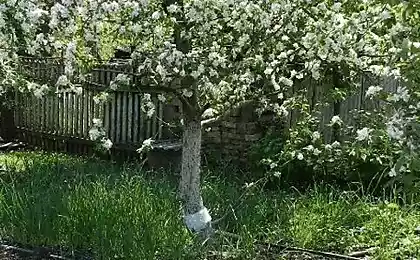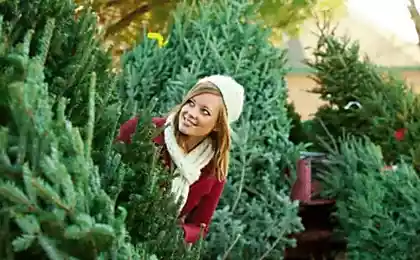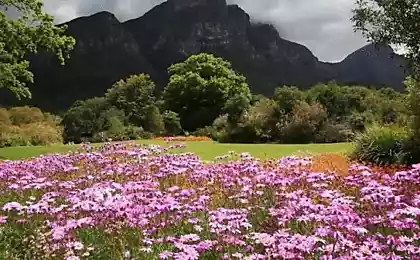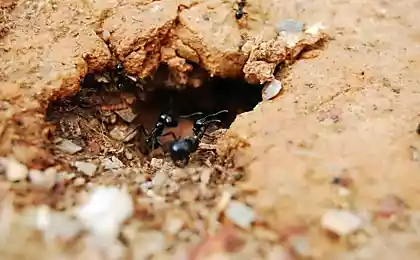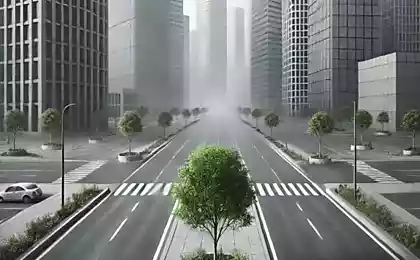146
The ants get out, make a fishing belt for them, safe for trees.
Countless hordes of ants and the herds of aphids they graze are a real scourge of gardeners. I want to cry when you see the young twigs of plums, turned from green black from the aphid clad on them. If chemical poison is definitely not your choice, it will save the ants' fishing belt.

This is a simple mechanical trap that is located on the trunk of a tree and does not allow pests to climb it. Especially effective means belt will be against those insects that winter in the ground, and in the spring return to feast young foliage. They include whiteflies, weevils, ants and aphids, flower eaters.
All hunting belts can be divided into dry, poisonous and sticky. You can buy them in the store, or you can make them with your own hands, which we will try to do.

The simplest option is a packaging film and a special glue, but this solution has one greasy minus. Under the belt, the bark is closed and after wetting it does not dry for a long time, which leads to its decay and cracking.

More convenient looks fishing cone of polyethylene foam. It less closes the bark, does not prevent it from breathing, but it is easy to manufacture, is not afraid of dust and moisture and copes with its task perfectly. From materials you will need foamed polyethylene (it is used as a substrate under the laminate), wire or cord, glue, stapler, scissors.

Cut a rectangular piece of polyethylene foam and tie it around the tree under a slope. It turns out to be something like a big bag for seeds, turned upside down.

Tie the top tightly with wire or, in my case, twine. Stapler the edges. Then lift the resulting "skirt" up and smear its interior with viscous glue.
It can also be resin, birch tar or, for example, a special glue for insects such as Ecotrap.

Glue Ecotrap has many advantages: tractor and resistant, non-toxic, does not contain poisonous substances and, most importantly, does not dry throughout the season.

Carefully lower the cone and further lubricate its upper surface. Now the ants will crawl into the bottom of the cone and become firmly stuck in the adhesive layer. And the glue on the upper surface of the skirt will catch those insects that are trying to go down. A simpler, but less reliable and durable option is to glue a layer of fabric, paper, bags, paint tape or even cotton wool wrapped around the tree.
Rules for the use of the fishing belt
As you can see, fishing belts act as an environmentally friendly alternative to insecticides and, with their relative simplicity and low cost, allow you to cope with a lot of pests.

This is a simple mechanical trap that is located on the trunk of a tree and does not allow pests to climb it. Especially effective means belt will be against those insects that winter in the ground, and in the spring return to feast young foliage. They include whiteflies, weevils, ants and aphids, flower eaters.
All hunting belts can be divided into dry, poisonous and sticky. You can buy them in the store, or you can make them with your own hands, which we will try to do.

The simplest option is a packaging film and a special glue, but this solution has one greasy minus. Under the belt, the bark is closed and after wetting it does not dry for a long time, which leads to its decay and cracking.

More convenient looks fishing cone of polyethylene foam. It less closes the bark, does not prevent it from breathing, but it is easy to manufacture, is not afraid of dust and moisture and copes with its task perfectly. From materials you will need foamed polyethylene (it is used as a substrate under the laminate), wire or cord, glue, stapler, scissors.

Cut a rectangular piece of polyethylene foam and tie it around the tree under a slope. It turns out to be something like a big bag for seeds, turned upside down.

Tie the top tightly with wire or, in my case, twine. Stapler the edges. Then lift the resulting "skirt" up and smear its interior with viscous glue.
It can also be resin, birch tar or, for example, a special glue for insects such as Ecotrap.

Glue Ecotrap has many advantages: tractor and resistant, non-toxic, does not contain poisonous substances and, most importantly, does not dry throughout the season.

Carefully lower the cone and further lubricate its upper surface. Now the ants will crawl into the bottom of the cone and become firmly stuck in the adhesive layer. And the glue on the upper surface of the skirt will catch those insects that are trying to go down. A simpler, but less reliable and durable option is to glue a layer of fabric, paper, bags, paint tape or even cotton wool wrapped around the tree.
Rules for the use of the fishing belt
- Place the belt at a height of 30-60 centimeters from the ground.
- If possible, set the belt before the kidneys open.
- Check your belts every 2-3 days and kill any insects you catch.
- On stone trees remove after harvest, and on pears and apple trees leave until early November.
As you can see, fishing belts act as an environmentally friendly alternative to insecticides and, with their relative simplicity and low cost, allow you to cope with a lot of pests.
Turkish pop cooks acmu, homemade cozy recipe for Turkish soft buns
What to do musicians, because you need to sing, rehearse, play musical instruments, and neighbors are against




